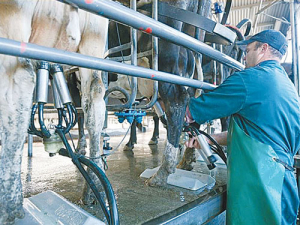Calf rearers say goodbye to leaky teats, poor feeder fit
Leaky teats and poor feeder fit are now a thing of the past for calf rearers - thanks to the Thriver range of calf teats from Skellerup.
 Halving bulk milk somatic cell counts from 300,000 to 150,000 is estimated to increase total season milksolids by 2.1%.
Halving bulk milk somatic cell counts from 300,000 to 150,000 is estimated to increase total season milksolids by 2.1%.
Filling the vat with the best milk you can produce is a financial advantage, says milking liner maker Skellerup.
Studies have shown hefty production gains from maintaining good milk quality, the company says. For example, halving bulk milk somatic cell counts (BMSCC) from 300,000 to 150,000 is estimated to increase total season milksolids by 2.1%
In general, the lower your somatic cell count (SCC) and the fewer grades incurred during lactation, the more efficient and thorough is your milking process.
Attention to detail and a preventative approach go a long way towards improving milk quality, and this is the ideal time of year to review your system, says Skellerup. A key question to ask is: when did we last replace the liners?
Milking liners are the one item in direct contact with the cow. During each lactation she typically spends 50-100 hours attached to the machine, via those liners.
“Milking liners are hidden inside the shells, so you can’t see what happens to them when they wear out,” says Skellerup national manager Perry Davis.
“The first thing you might see instead is a cow kicking the cluster off, damaged teat ends or a surprisingly high BSCC on the milk docket.”
Worn, poor-fitting liners can leave milk in the udder, slip off the teat and/or leave permanent rings at the top of the teat. And any internal cracks in the rubber are an ideal environment for bacteria.
Skellerup offers an easy way to check if milking liners are due for replacement: go to www.2500change.co.nz and fill in the required fields or use a calculator to work out how many times they’ve been used since they were installed.
If it’s 2500 or more, it’s time to change, Davis says.
Three New Zealand agritech companies are set to join forces to help unlock the full potential of technology.
As the sector heads into the traditional peak period for injuries and fatalities, farmers are being urged to "take a moment".
Federated Farmers says almost 2000 farmers have signed a petition launched this month to urge the Government to step in and provide certainty while the badly broken resource consent system is fixed.
Zespri’s counter-seasonal Zespri Global Supply (ZGS) programme is underway with approximately 33 million trays, or 118,800 tonnes, expected this year from orchards throughout France, Italy, Greece, Korea, and Japan.
Animal owners can help protect life-saving antibiotics from resistant bacteria by keeping their animals healthy, says the New Zealand Veterinary Association.
According to analysis by the Meat Industry Association (MIA), New Zealand red meat exports reached $827 million in October, a 27% increase on the same period last year.